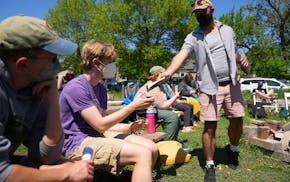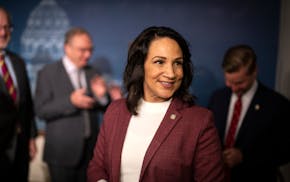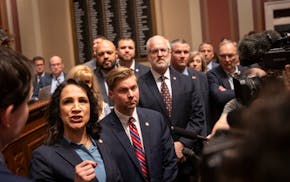Students at most of Minnesota's public colleges and universities won't have to worry about rising tuition when they return to school this fall.
All seven Minnesota State universities and its 30 community colleges are freezing tuition, under a legislative mandate.
At the same time, the University of Minnesota has proposed a tuition freeze at three of its five campuses, in Crookston, Duluth and Rochester. On Friday, the regents are expected to vote on the plan, which also would raise in-state tuition in Morris and the Twin Cities by 1 to 2 percent.
If approved, the sticker price would be just over $13,000 a year.
Even so, says U President Eric Kaler, the trend is clear. After years of sometimes eye-popping tuition hikes, the rate of increase for Minnesota residents on public campuses has slowed to a crawl.
As recently as 2005, the U was raising in-state tuition by as much as 14 percent a year, and its rates soared from $4,401 to more than $10,000 in the space of a decade.
But since 2012, the year after Kaler took office, the U has kept its average tuition increase to 1 percent a year in the Twin Cities, and half a percent on its other campuses. That is, Kaler says, the lowest rate in 58 years.
"We have bent that cost curve, with help from the Legislature," he said. "I think it's a big deal, frankly." But not everyone has noticed, he says, because of the "national narrative of out-of-control tuition increases."
Across the country, tuition hikes have started to moderate, but not as much as those in Minnesota, says Robert Kelchen, an expert in higher education trends at Seton Hall University in New Jersey.
"There's been a little bit of a slowdown over the last five or six years, but in general, tuition is increasing about or just above the rate of inflation, roughly 2 or 3 percent," he said. "Minnesota is on the low end."
In fact, tuition costs at the state's public campuses have lagged behind inflation for most of the decade, experts say.
"I think we're all conscious of the fact that it's slowed," says Kayla Shelley, a 20-year-old communications major at St. Cloud State, and incoming chairwoman of Students United, the student group at the Minnesota State universities. Their tuition rate — $7,287 — has grown by an average of 1 percent a year since 2012.
But the students who are footing the bill don't feel much relief, Shelley said. "The cost is still astronomical," she said.
The slowdown has been more dramatic at Minnesota's two-year public colleges, where the average full-time tuition, $4,815, is the same now as it was in 2012.
"Our students really believe that the tuition freeze has been helping," said Cecilia Damian, 21, a student leader at Inver Hills Community College. Her organization, LeadMN, has lobbied to rein in tuition and fees at Minnesota's community colleges, which historically have been among the highest in the country.
The tuition turnabout began in 2012, when leaders of the U and the Minnesota State system struck a deal with state lawmakers to freeze tuition through 2015 in exchange for a bump in state funds.
Since then, both the U and Minnesota State have sought to repeat the deal, with mixed results.
But legislators and others, including members of the U's Board of Regents, have stepped up pressure to keep tuition down for Minnesota residents.
The result, officials say, has put state campuses in a financial bind.
"Each year, you're faced with a budget challenge," said Kaler. "If state support declines or doesn't increase, then your choices are to increase tuition or reduce the quality."
Few choices
Devinder Malhotra, the Minnesota State chancellor, notes that the Legislature has left him with few choices: It has imposed a tuition freeze next year without extra state funds to help cover rising costs.
"Our state appropriations have been increasing, but not at a rate that would cover the cost of tuition freezes," he said. So for now, that means cutting costs — about $34 million across the system's 54 campuses — and making do with less.
The U, which operates independently, is not bound by legislative limits on tuition. But several members of the Board of Regents have been pushing to bar any increase for state residents.
"I think it's definitely realistic," said Regent Michael Hsu. "The question is whether [a tuition hike] is necessary. I don't believe it is." In May, his proposal to freeze tuition on all campuses was voted down by the board. But it's expected to come up again when the board meets June 8 to set next year's rates.
Kaler, though, defends his request to raise tuition by $126 in Morris and $258 in the Twin Cities.
"You can't simply say we can just cut, cut, cut and it won't affect the quality of the educational opportunity we provide," he said. "I believe we're worth an investment of a very modest tuition increase."
At this point, no one is predicting what will happen to tuition a year from now. But Shelley, of Students United, says she hopes state lawmakers will step in to help her fellow students.
"We have two sources of income for these universities," she said. "One has the ability to keep up with inflation, and that's the state. And the other doesn't, and that's students."
Maura Lerner • 612-673-7384

Want to share info with the Star Tribune? How to do it securely

'Safe recovery sites' would offer syringes, naloxone and more to people using drugs. The plan could be in peril.
New Minnesota GOP leaders seek peace with party's anti-establishment wing

Who is Republican Lisa Demuth, Minnesota's first House speaker of color?

